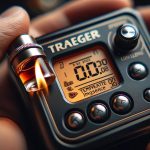Did you know that approximately 30% of pellet smoker owners report experiencing issues with their devices overheating at some point? This statistic underscores a significant challenge in the seemingly straightforward process of smoking meat.
When it comes to using a Traeger smoker, ensuring that it operates at the correct temperature is crucial for achieving that perfectly smoked brisket or succulent rack of ribs. However, when your smoker overheats, not only does it compromise the quality of your food, it could also pose safety hazards.
This blog post will dissect the common reasons why a Traeger smoker might overheat and offer practical advice on how to prevent this issue from ruining your barbecue. Here are some of the insights we will cover:
- The Impact of Pellet Quality: How low-quality pellets can cause your smoker to work overtime.
- Maintenance Musts: Essential cleaning and upkeep tips to keep your Traeger in top shape.
- Airflow Awareness: The role of proper ventilation in maintaining the right temperature.
- Sensor Sensitivity: How to check and adjust your Traeger’s temperature sensors for accuracy.
Understanding these factors can help you maintain your smoker better and enjoy many successful barbecues. Whether you’re a seasoned pitmaster or a newcomer to the world of smoking meats, mastering these elements will ensure that your Traeger performs optimally every time you fire it up.
Contents
- 1 What Issues Occur at a High Internal Temperature
- 2 Is Your Traeger Temp Too High? – The Common Causes
- 3 AC Traeger Grill
- 4 App Out Of Date
- 5 Dirty Or Faulty RTD Probe
- 6 How An Error Code Can Indicate A Heat Issue
- 7 Maintaining Your Traeger To Avoid Temp Spikes and Fires
- 8 Other Common High-Temperature Issues and Fixes
- 9 The Optimum Temperature Range
- 10 Conclusion
What Issues Occur at a High Internal Temperature
There are several potential problems that can arise when a Traeger smoker reaches a high internal temperature. These include burning food, risk of food poisoning, fire hazards, damage to internal components, and loss of excess heat.
One of the main reasons for high internal temperatures in Traeger grills is hot weather. This can cause the grill to get too hot, leading to issues such as burning food and potential food poisoning. To prevent this, it is important to move the grill to a shaded area or adjust the P-setting button to help with ambient temperature changes. Opening the lid for 5 minutes can also help lower the temperature if it is too hot.
Another potential problem is a faulty temperature probe or incorrect start-up processes. This can lead to inaccurate temperature readings and overheating. To avoid this, make sure the grill lid is closed during start-up and follow the correct procedure for your specific model. Regular maintenance such as cleaning after use and checking for grease buildup can also prevent issues with pellets running out or disruptions in pellet flow.
Traeger also offers WiFIRE enabled grills that allow remote temperature control through an app. However, issues with the RTD probe (which measures internal temperature) may result in inaccurate readings and require calibration or replacement. An HEr error code on the control panel indicates a high temperature above 550°F, which can be dangerous and may require calling emergency services.
In addition, malfunctioning critical components such as the auger motor, control board, induction fan, or hot rod can also lead to overheating. Identifying and replacing these faulty parts is essential for proper functioning of the grill. It is also important to keep firmware and app updates current for Traeger WiFIRE grills to avoid inaccurate heat regulation.

Overall, regular maintenance and proper alignment of critical parts are key to preventing overheating in Traeger grills. It is also important to use separate probes for accurate readings as damaged probes can affect the results.
Is Your Traeger Temp Too High? – The Common Causes
The most common causes of a Traeger smoker getting too hot include initial flare-ups, high ambient temperatures, and faulty components.
To address these issues, make sure to start with a clean firepot and follow proper firing procedures. Additionally, calibrate the P-setting to regulate temperature in hot weather and regularly clean or replace the resistance temperature detector (RTD).
If these measures do not solve the problem, check for faulty components such as the auger motor, control board, induction fan, or hot rod and replace as needed.
AC Traeger Grill
The AC unit in a Traeger grill is pivotal in maintaining the correct cooking temperatures which are crucial for achieving that perfect smoke ring and tender meat texture.
It primarily functions to regulate the internal temperature of the grill by controlling the delivery and burning of wood pellets, which are the fuel source. Here’s a breakdown of how this impacts the heat levels:
- Wood Pellet Delivery: The AC unit powers the auger that feeds wood pellets from the hopper to the firepot. The steady and controlled movement of pellets ensures a consistent flame and temperature.
- Temperature Regulation: The grill’s thermostat interacts with the AC unit to adjust the auger’s speed. This can increase or decrease the number of pellets fed into the firepot, directly impacting the grill’s internal temperature.
- Heat Distribution: The fan, also powered by the AC unit, aids in dispersing the smoke and heat evenly throughout the cooking chamber. This not only helps in cooking the food evenly but also imparts that quintessential smoky flavor.
Faults or malfunctions in the AC unit can lead to significant issues:
- Temperature Swings: If the auger is blocked or the motor is faulty, the delivery of pellets becomes erratic, causing temperature fluctuations that can ruin the cooking process.
- LEr Code Errors: A dysfunctional AC unit might fail to maintain the necessary temperature, potentially shutting down the grill if it drops below 125°F, indicated by the LEr error.
| Component | Role | Potential Issues |
| Auger | Delivers pellets to the firepot | Blockages, motor failures |
| Thermostat | Regulates pellet feed rate | Misreads temperature |
| Fan | Spreads heat and smoke | Inconsistent cooking |
By ensuring the AC unit and its components are functioning correctly, you safeguard the quality of your barbecue, avoiding common pitfalls such as uneven cooking and temperature-related errors that could impede the performance of your Traeger grill.
App Out Of Date
An outdated app can significantly impact the performance of a Traeger smoker, particularly affecting its temperature control, which is crucial for achieving that perfect barbecue. This scenario often unfolds due to the app’s inability to communicate effectively with the grill’s latest firmware, leading to mishandled temperature settings.
Impact of an Outdated App on Traeger Temperature:
- Miscommunication: An outdated app might not properly interpret or set the grill’s temperature according to user inputs, leading to higher than intended heat.
- Firmware Incompatibility: If the grill’s firmware is updated but the app is not, discrepancies in digital signaling can cause erroneous temperature outputs.
- Delayed Feedback: Users may experience lag in temperature adjustments due to delayed updates from the app, causing the smoker to overheat if manual intervention is delayed.
Table of Problems and Solutions:
| Issue | Impact | Solution |
| App-Firmware Incompatibility | Unintended temperature spikes | Update the app to match grill firmware |
| Delayed User Interface | Overheating due to slow response | Check connectivity and ensure app is responsive |
| Incorrect Temperature Setting | Excessive heat damaging food quality | Manually verify and adjust grill settings |
For a smoother and safer barbecue experience, it’s advisable to keep both the Traeger smoker’s firmware and the controlling app up-to-date. This ensures they work harmoniously, maintaining the correct temperature for the best cooking results. Remember, a well-maintained smoker coupled with current software will keep your BBQs flawless and your meats perfectly smoked.
Dirty Or Faulty RTD Probe
A dirty or faulty RTD probe can cause a Traeger smoker to get too hot by providing incorrect temperature readings and not communicating properly with the temperature controller.
This can lead to dangerously high temperatures, risking food poisoning, fire hazards, and damage to internal components. Regular maintenance such as cleaning after use and checking for unburnt pellets can prevent this issue.
Additionally, factors such as hot weather and improper start-up procedures can also contribute to high temperatures. To troubleshoot this issue, one should check for visible damage on the RTD sensor and compare temperature readings with another probe.
If there is a significant difference, the probe may need to be calibrated or replaced.
How An Error Code Can Indicate A Heat Issue
Error codes on your Traeger smoker act like a secret language that the machine uses to communicate specific heat-related troubles. By understanding what each code signifies, you can swiftly diagnose and mend issues, ensuring your BBQ sessions run smoothly without hitches.
For instance, different error codes indicate varying problems, from overheating to connection errors. Here’s a breakdown of how each code can help you manage and resolve heat issues:
| Error Code | Meaning | Action to Take |
| LEr | Low Temperature Error – Grill temperature has dropped below 125°F for more than 10 minutes. | Check and ensure the pellet hopper is full and the firepot is not obstructed. It might also help to reset the grill’s temperature settings. |
| HEr | High Temperature Error – Grill temperature has exceeded 550°F. | Allow the grill to cool. Check for a buildup of pellets in the firepot or a malfunctioning fan that could be causing insufficient air flow. |
| ERR | General connection error between the RTD temperature probe and the control panel. | Inspect the connections for the RTD probe. Tighten any loose connections and ensure the probe is not damaged. |
| ER1 | Controller failure – This code can appear alongside other errors like ERR. | Reset the control panel. If the problem persists, contact Traeger support for a potential replacement of the controller. |
| ER2 | RTD probe failure – Indicates a malfunction with the temperature probe. | Check the RTD probe for damage or wear. Replacement of the probe or sometimes the controller might be required. |
By following the steps outlined for each error, you can effectively tackle most heat-related issues in your Traeger smoker. Regular maintenance, such as cleaning the firepot and ensuring the pellet hopper is full, can help prevent these errors and maintain optimal performance.
Maintaining Your Traeger To Avoid Temp Spikes and Fires
Proper maintenance of a Traeger smoker can help prevent temperature spikes and fires by addressing potential issues before they become major problems.
In addition, promptly addressing any component failures or malfunctions can prevent uneven heating and potential fire hazards.
Other Common High-Temperature Issues and Fixes
Some common causes of a Traeger smoker getting too hot include initial flare-ups, high ambient temperature, broken thermocouple, faulty auger motor, induction fan, hot rod, or control board.
These issues can be fixed by removing partially burnt pellets and cleaning the firepot, adjusting the P-setting for hot weather conditions, cleaning or replacing the thermocouple, ensuring all removable parts are properly aligned and cleaned, replacing damaged components, adjusting the position of the hot rod, updating firmware and using quality pellets recommended by Traeger.
The Optimum Temperature Range
The ideal temperature range for a Traeger smoker is between 180-225 degrees Fahrenheit. This range allows for slow cooking and smoking, which results in tender, flavorful meat. Maintaining this temperature range is crucial in order to achieve the best results when smoking meat.
There are a few considerations to keep in mind when it comes to maintaining the ideal temperature range on a Traeger smoker. Firstly, the Smoke and 180 degree settings play important roles in achieving this range. The Smoke setting helps start up the grill and prevents acrid white smoke, while the 180 degree setting is used for slow smoking and holding food at a safe temperature. It’s essential to properly set and monitor these settings in order to maintain the desired temperature range.
Furthermore, maintaining a consistent temperature range is important because it allows for the meat to absorb smoke flavor evenly and effectively. Cold meat absorbs more smoke flavor than hot meat, so it’s crucial to keep the temperature range within the recommended range for the best results.
In addition, keeping a consistent temperature range also ensures that the meat is cooking at a safe temperature to prevent undercooking or overcooking. This helps prevent any potential foodborne illnesses and ensures that the meat is cooked to perfection.
Conclusion
Understanding why your Traeger smoker might be overheating is crucial to maintaining both safety and quality in your smoking process. A Traeger operating at excessively high temperatures can lead to overcooked food, potential food poisoning from improperly cooked proteins, and even pose a risk of fire hazards due to overheated components.
One common culprit for a Traeger running hot is the quality of pellets used; inferior pellets can burn hotter and faster, disrupting the balance needed for that perfect low and slow cook. Ensuring your smoker is clean and the airflow is unobstructed is equally important, as buildup and blockages can also lead to temperature spikes. Regularly checking and adjusting the temperature sensors will help in providing accurate readings, thereby preventing these issues.
If your smoker starts running hot, consider the environmental conditions and the condition of internal components like the auger motor and the induction fan, which play significant roles in maintaining temperature control. Use the P-setting adjustments for finer control during hotter weather, and always ensure the RTD probe is clean and functional, as a dirty or faulty probe can send incorrect readings that lead to overheating.
In cases where the internal temperature exceeds safe limits, the smoker’s error codes can be your guide to troubleshooting—whether it’s an HEr code indicating excessive heat or an LEr pointing to temperature drops, understanding these signals can be critical.
By taking these proactive steps—selecting high-quality pellets, ensuring thorough maintenance, and understanding your Traeger’s feedback through error codes—you can enjoy consistent, perfectly smoked meats without the risk of overheating.






